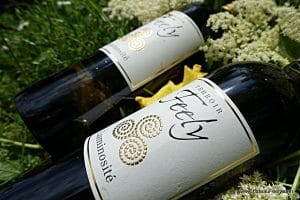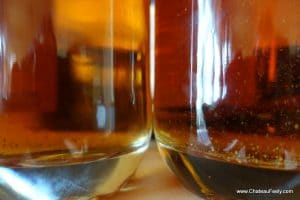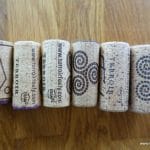Why use brown bottles for white wine?
Light damage and clear bottles
Wine drinkers like to see what is in the bottle so supermarkets often force winemakers to choose clear bottles,  especially for white and rosé.
especially for white and rosé.
Unfortunately, like oil, wine is damaged and degraded by light so a coloured bottle is better for storage.
Exposed to light the polyphenols (aroma compounds) can change; citrus aromas decrease and cooked cabbage aromas increase. Vitamins are also degraded by UV light. Wine (especially good healthy naturally farmed organic and biodynamic wine) can include vitamins B2 (riboflavin), B6 and B12 and trace levels of A, C and K along with other useful minerals like manganese, zinc, copper and selenium. Brown glass is best, followed by green and, in last place, the least effective for protecting the wine from light damage is clear glass.
Deposits in your wine
While on the subject of bottles another reason it is a good opportunity to talk about deposits.
Wine made naturally often throws a deposit at the bottom of the bottle. This can be tannins that have come together and settled out, tartaric crystals or other natural particles from the grapes and fermentation if the wine was not fined and filtered.
was not fined and filtered.
Sometimes you can even find tartaric crystals on the inside of your cork that look like little shards. This is perfectly fine, and in fact better for you and for your wine. A wine that has been heavily fined and filtered may be beautifully clear with no deposit but will have lost a part of its soul along the way. The tartaric acid is removed by chilling way way down (to around freezing- this is why you sometimes find tartaric crystals after chilling a wine when it wasn’t there before) or by adding a chemical product to make the tartaric acid crystallize out then the clear wine is racked off and the crystals left behind and got rid off. A side effect of doing this (all done to merely to make a nice crystal clear wine and no potential for deposit) is the wine now has less tartaric acid so less total acid and hence needs more sulfites.
Three main acids exist in wine grapes: tartaric acid, malic acid and citric acid. Tartaric acid is the one that throws (tartrates out) the tartaric crystals. Malic acid is the one that turns to lactic acid for most reds (except among others the likes of Beaujolais nouveau) as part of the wine-making process. Citric acid is the one we find in citrus and is in small amounts in grapes and wine – there is about 20 times more tartaric acid than citric acid in ripe grapes.
Learn more about wine with out Wine school or read Caro’s books Grape Expectations , Saving our Skins and latest book Glass Half Full to learn more about wine and the story of building an organic vineyard.
Join our mailing list at the bottom right of the homepage to stay up to date with our news. Let me know if there are any wine, wine pairing or organic farming topics you would like to see blog posts on. Read about the animals at chateau feely .










[…] are also degraded by UV light. Wine (especially good, healthy, naturally farmed organic and biodynamic wine) can include vitamins […]